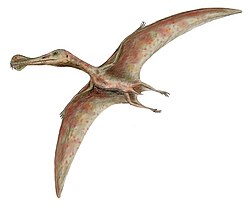Ornithocheirus
| Ornithocheirus Temporal range: Early Cretaceous
| |
|---|---|

| |
| Ornithocheirus sp. | |
| Scientific classification | |
| Kingdom: | |
| Phylum: | |
| Class: | |
| Order: | |
| Suborder: | |
| Family: | |
| Genus: | Ornithocheirus Seeley, 1869
|
| Species | |
|
O. simus Seeley, 1869 (type) | |
| Synonyms | |
|
Criorhynchus Owen, 1874 | |
Ornithocheirus (from Greek "ορνις", meaning bird, and "χειρ", meaning hand) was a huge pterosaur from the early Cretaceous period of Europe and South America. Along with Quetzalcoatlus, several large bone fragments from the Santana Formation of Brazil indicate that Ornithocheirus may have been one of the largest pterosaurs that ever lived, with a wingspan reaching almost 12 m (40 ft).[citation needed] If these poorly preserved remains do indeed belong to Ornithocheirus, it would have been approximately 3.50 m (11.5 ft) long (1.50 m (5 ft) of which belonged to the head) and stood approximately 3 m (10 ft) tall when on the ground on all fours. Despite this, the creature would only have weighed as much as a grown man (70 kg)[dubious – discuss], thanks to hollow bones filled with air sacks. Ornithocheirus was the earliest giant pterosaur, living 125 million years ago. Most other large-sized genera appeared around 90 million years ago.


Though many species have been named in the genus Ornithocheirus over the years, only three (O. simus, O. mesembrinus, and a yet-unnamed third species) are currently recognized as valid by most pterosaur researchers. Part of the confusion lies in the fact that the type specimen of Ornithocheirus is poorly preserved, and difficult to tell apart from related pterosaurs (such as Anhanguera). The famous "keel-jawed" pterosaur specimens originally assigned to Ornithocheirus (as O. mesembrinus) have even been assigned to their own genus (Tropeognathus mesembrinus), though today many researchers, including David Unwin, agree that these are indeed species of Ornithocheirus (making Tropeognathus a junior synonym) [1].
Other species erroneously assigned to Ornithocheirus:
- Ornithocheirus clifti (Mantell 1835) Newton 1888
- Ornithocheirus curtus (Owen 1870) Newton 1888
- Ornithocheirus diomedeus (Owen 1846) Newton 1888
- Ornithocheirus "macrorhinus" (Jukes-Browne 1875)
- Ornithocheirus "oxyrhinus" (Owen 1870)
- Ornithocheirus hlavatschi (Fritsch, 1905)
- Ornithocheirus weidenrothi (Wild 1990)
- Ornithocheirus bunzeli (Seeley 1881) (possibly an azhdarchid)
Cimoliornis, Cretornis, and Paleornis, misidentified as birds, have been assigned to Ornithocheirus, but they may instead be separate genera, a position held by David Unwin.
In popular culture
Ornithocheirus was featured in an episode of the BBC television program Walking with Dinosaurs, and made a brief appearance in the related series Chased by Dinosaurs. In Walking with Dinosaurs, it was identified as the largest pterosaur to ever live; however, other pterosaurs such as Hatzegopteryx and Quetzalcoatlus are known to have grown as large or larger.
References
- Haines, T., and Chambers, P. (2006). The Complete Guide to Prehistoric Life. Canada: Firefly Books Ltd.
